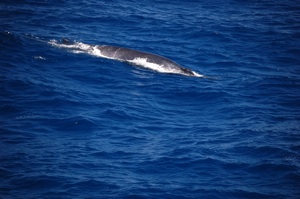Marine Mammal Species Description
Bryde's Whale
Balaenoptera edeni
Anderson, 1879

Photo credit: Lieutenant Elizabeth Crapo, NOAA
Classification
Order: Cetacea
Family: Balaenopteridae
Alternate Common Names:
Status: protected under MMPA
Description:
Length: 39-51 ft (12-15.6 m)
Weight: 24,900-35,700 lbs (11,300-16,200 kg)
Bryde's whales have a long falcate dorsal fin that rises at an abrupt angle from their back about two-thirds of their length from the tip of their nose to their flukes. They have three ridges on their head. One ridge runs down the center of their rostrum and one ridge runs on either side of the central ridge. They have 40-70 ventral grooves or pleats that cover the area from their lower jaw to their navels. These whales are in the suborder Mysticeti, or the baleen whales. Baleen whales do not have teeth, but have plates attached to their upper jaws. These baleen plates are hard, but flexible, which baleen whales use to filter their food from the water. They are dark gray above with a dark throat and dark flippers. They are white underneath.
Habitat:
Bryde's whales occur most often in tropical and warm, temperate waters. They occur singly, in groups of two or three or rarely in groups around ten individuals.
Feeding:
Bryde's whales eat mostly fish, but also eat crustaceans (krill) and copepods. They have been recorded diving to depths of 984 ft (300 m).
Reproduction:
Bryde's whales reach sexual maturity when they reach around 36-43 ft (11-13 m) length or about 7-13 years old. An individual female will give birth about every 2-3 years. The gestation period is about 11-12 months after which females give birth to a single calf. Females nurse their young for about 6 months.
Other:
Distribution / Range:
Bryde's whales occur in the tropical and warm temperate regions worldwide. They tend to travel closer to the equator during the winter and into the warm, temperate zones in the summer.
Similar species:
The most similar species to Bryde's whales are fin and sei whales. The three ridges on the head of the Bryde's whales can help identify them from these other species.
Notes:
References:
American Cetacean Society. 2004. American Cetacean Society Fact Sheet. http://www.acsonline.org/factpack/SeiBrydesWhales.htm. Accessed January 2012.
Jefferson, T.A., S. Leatherwood, and M.A. Webber. 1993. FAO species identification guide. Marine mammals of the world. Rome, FAO. 320 p. 587 figs.
Kato, H. and W.F. Perrin. 2009. Bryde?s Whale - Balaenoptera edeni/brydei. In: Encyclopedia of Marine Mammals 2nd Ed. Perrin W.F., B. Würsig, and J.G.M. Thewissen, eds. Academic Press, New York, pp. 158-163.
Reilly, S.B., Bannister, J.L., Best, P.B., Brown, M., Brownell Jr., R.L., Butterworth, D.S., Clapham, P.J., Cooke, J., Donovan, G.P., Urbán, J. & Zerbini, A.N. 2008. Balaenoptera edeni. In: IUCN 2011. IUCN Red List of Threatened Species. Version 2011.2. www.iucnredlist.org. Downloaded on 09 January 2012.
Rice, D.W. 1999. Bryde?s whale, Balaenoptera edeni. In The Smithsonian Book of North American Mammals. Wilson, D.E. and S. Ruff, eds., 249-251. Smithsonian Institution in association with the American Society of Mammologists, Washington DC.

 Marine Mammals of Georgia
Marine Mammals of Georgia